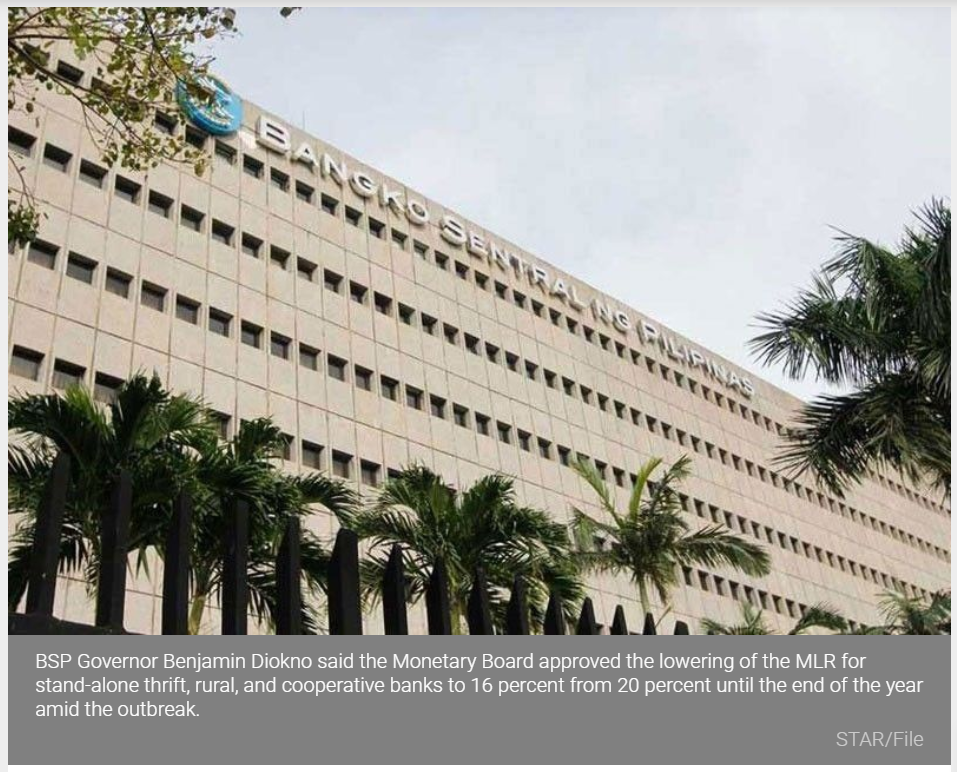Philippines: BSP cuts liquidity ratio of banks, frees up P10 billion
MANILA, Philippines — The Bangko Sentral ng Pilipinas (BSP) has temporarily lowered the minimum liquidity ratio (MLR) for stand-alone mid-sized and small banks, freeing P10 billion into the financial system and boosting economic activity amid the coronavirus disease 2019 or COVID-19 pandemic.
BSP Governor Benjamin Diokno said the Monetary Board approved the lowering of the MLR for stand-alone thrift, rural, and cooperative banks to 16 percent from 20 percent until the end of the year amid the outbreak.
“The BSP recognizes that the COVID-19 outbreak and community quarantine implemented to combat the spread of the disease has elevated the liquidity risk exposures of banks arising primarily from higher demand for funds by depositors, borrowers, or both,” Diokno said.
Owing to the regulator’s adoption of liquidity standards, Diokno said banks are largely seen to have entered the current situation in a strong liquidity position with buffers ready to absorb the recent and coming liquidity shocks.
Mid-sized and small banks are required by the central bank to maintain a stock of liquid assets proportionate to their on- and off-balance sheet liabilities to promote short-term resilience of liquidity shocks.
The liquidity ratio is expressed as a percentage of a bank’s eligible stock of liquid assets, including cash on hand, reserves in the BSP, overnight and term deposits with BSP, deposits in other banks, eligible debt securities, among others to its total qualifying liabilities.
“As the liquidity buffers are designed to be used in periods of stress, stand-alone thrift banks, rural banks, and cooperative banks may draw on their stock of liquid assets to meet liquidity demands to respond to the current circumstances, remaining cognizant of the MLR of 16 percent,” Diokno said.
According to the BSP, a bank that has recorded a shortfall in the stock of eligible liquid assets on three banking days within any two-week rolling calendar period must notify the regulator of such breach on the banking day immediately following the occurrence of the third liquidity shortfall.
Suzanne Felix, executive director of the Chamber of Thrift Banks (CTB), said earlier the reduction in the MLR to 16 percent from 20 percent would immediately release about P10 billion for relending to consumers as well as the micro, small and medium enterprises (MSMEs).
“The MLR reduction will greatly support MSMEs and consumers in this crisis. This will have a positive impact in terms of giving thrift banks the ability to lend more to MSMEs particularly in the countryside,” Felix said.
Felix said MSMEs and consumers are the major niche markets of thrift banks.
“In light of the expected major economic downturn coming soon due to the coronavirus pandemic, a monetary policy which involves making more liquidity available now will be most welcome,” Felix said.
Data from the BSP showed assets of Philippine banks stood at P18.7 trillion as of end-2019, of which big banks dominated 92 percent or P17.22 trillion. On the other hand, assets of thrift banks reached P1.2 trillion, while that of rural and cooperative banks amounted to P285 billion.
Source: https://www.philstar.com/business/2020/04/09/2006373/bsp-cuts-liquidity-ratio-banks-frees-p10-billion


 English
English




